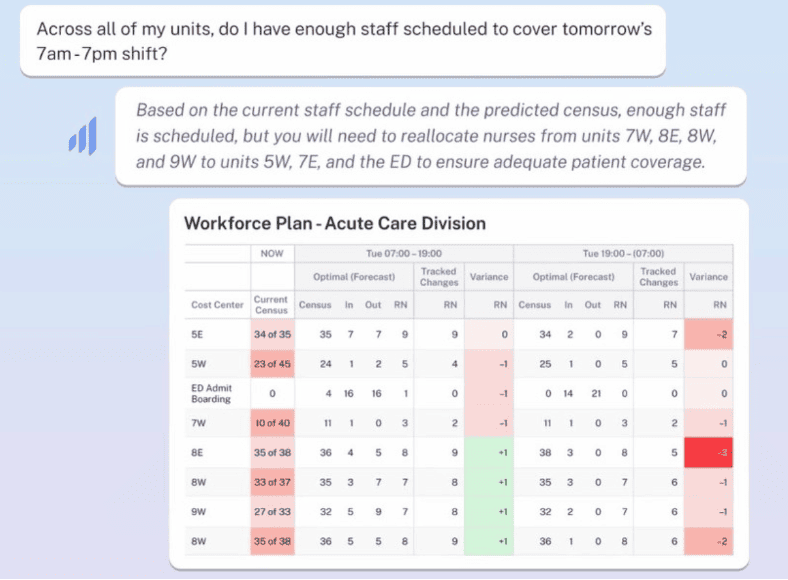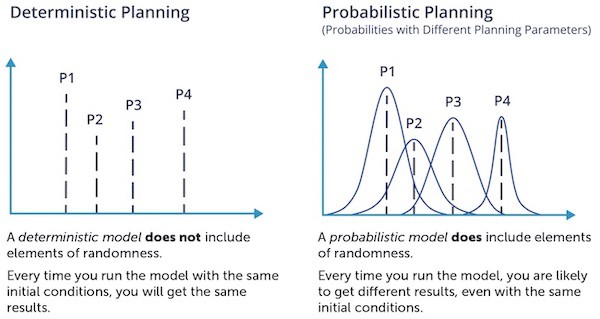LeanTaaS Unveils Generative AI Hospital Operations Solution, iQueue Autopilot
Key Takeaways
LeanTaaS, one of the early innovators we’ve covered in the AI4Ops space, recently launched one of the first generative AI solutions for hospital operations. LeanTaaS has a focus on optimizing hospital asset utilization across hospital beds, surgical theaters, and infusion chairs. This is one of the first generative AI tools that we have seen reach the market in this space.
The tool is part of a broader set of capabilities around “Transformation-as-a-Service” that highlights the role of change management in a more robust manner from when we covered LeanTaaS in our 2021 AI4Ops report. When we first interviewed LeanTaaS two years ago, our analysis identified them as the strongest vendor in the space, but they placed less emphasis on the change management component than many competitors. They appear to be investing more in this area with the new suite of tools.
Some early insights from LeanTaaS on the performance of models relative to the nature of the tasks – deterministic vs. probabilistic – provide a more nuanced understanding of risks and extent of the need for safety guardrails. Much of the early anecdotal evidence of the performance of generative AI in healthcare has been with GPT3 or GPT4 and general prompts by clinicians. LeanTaaS works with more deterministic operations with task-specific data for their optimization engines that demonstrates far fewer risks of “hallucinations” or misinformation/miscalculations.
LeanTaaS and iQueue Autopilot
In early June LeanTaaS announced the launch of their “iQueue Autopilot”, a generative AI solution for hospital operations. The tool is designed to provide actionable insights and “human-like conversations” for hospital staff responsible for patient flow, scheduling, command center, block management and staffing to serve capacity management. However, there are some important differences to cover between their approach to generative AI, and the now-famous GPT4/Bard/MedPaLM2 approach.
We first covered LeanTaaS as part of our AI4Ops report in 2021. They have hospital operational data from over 175 health systems from which to build out their AI tools. In 2021, as many systems were bringing elective surgeries back online to recover revenue hit by the pandemic, LeanTaaS played a notable role at the systems who worked with them by improving efficiencies and resource allocation across hospital assets that contribute to revenues in substantial ways. In June 2022 Bain Capital Private Equity acquired a majority stake in LeanTaaS enabling more growth after demonstrating already impressive results in the previous years. Earlier this year they, acquired competitor Hospital IQ.
From a demo on their website one can see how the iQueue Autopilot works for users. Across the various use cases in scheduling, block management, etc. the generative AI app can be queried for recent trends in utilization of hospital assets down to the individual surgeon, for example. The output of the app will instantly provide an overview of the trend queried and users can enter prompts that request recommendations for how to respond to given trends or utilization patterns. It essentially automates a great deal of data that would normally be provided in multiple dashboards that users would have to navigate.

iQueue Autopilot output (source: LeanTaaS)
Users have option for 3 different methods of queries:
- Lean Forward: Provides best practices and recommendations for capacity optimization management. For example, real-time staffing management recommendations, block or infusion center utilization best practices
- Lean Back: Provides alerts throughout the day for blockages or staffing roadblocks accompanied by suggestions for the best solution to address the problem
- Moment in Time Problem Solving: Real-time notifications of risks or problems associated with the various assets managed such as operating rooms or infusion centers. It then provides recommendations on how to proactively address issues before they become safety issues
This covers a pretty impressive set of challenges to hospital staff particularly in a period where staff burnout is one of the most critical challenges facing health systems.
Early Lessons from AI Optimization of Operations
I had the opportunity to have a brief conversation with Sanjeev Agrawal, President of LeanTaaS, who provided a deeper overview of the models they are using and some experiences in the early testing phase of development. They are currently experimenting with GPT4 and Med-PaLM2. He explained that both models have trade-offs but they find that the larger, broader models demonstrate more improvements from the prompts over time that make the interactions with humans better.
On the surface, this was a bit of a surprise to hear given the much talked about misinformation or hallucinations associated with the larger models such as GPT4. However, he explained how for their use cases they are dealing with a lot of structured data and tables from their clients that are cleaned and ingested into the LeanTaaS optimization algorithms.
The nature of LeanTaaS’ use cases is more deterministic, so generative AI enables users to utilize a prompt that does the work of clicking through numerous dashboards to arrive at an answer. Probabilistic tasks are far more complex tasks to resolve than the optimization of operations tasks that are LeanTaaS’ focus. The user, in other words, is not asking the agent to generate an output that could have a wider range of possible outputs than the deterministic tasks have.
It is worth reiterating another point. Even though they are using GPT4, the data used is only the data provided by their clients. The calculations and data are therefore outside of GPT4. Sanjeev explained the difference in their tool from many of the others is that they are leveraging the power of the encoder function of the LLM on deterministic functions which is a much easier and safer use case than those utilizing the decoder layer on probabilistic tasks.
Data hygiene is a critical component for delivering better predictions. LeanTaaS has a number of proprietary solutions that address data gaps from EHRs that also contribute to better performance. In cases where the input data is mostly unstructured (eg. patient summaries for Patient Flow cases) they utilize Reinforcement Learning from Human Feedback (RLHF) to fine tune the output from models.
I have been hearing a bit about some groups utilizing Wolfram as a plug-in that can be helpful for checking mathematical data outputs from chatgpt, for example. Tools like this are quite helpful in more clinically focused applications where physicians may query an agent for titrations of a medication. If the agent provided misinformation this could be deadly. Early testing of gpt3 and gpt4 mention problems with mathematical outputs from these models. In the clinical application side it appears that Atropos Health could be headed in this direction with their access to RWD or clinical trial data that can be used for difficult cases or rare diseases.
In our LeanTaaS example they are utilizing prompt engineering along with QA testing, structured input and mostly structured outputs to mitigate risk. When the system encounters mathematical problems the underlying architecture farms those problems out to subsystems (eg. relational database management systems) that can accurately manage them.
Conclusion
It is not surprising to see a generative AI application for hospital operations becoming one of the early models to be tested across a number of health systems. LeanTaaS is one of the leading vendors in the AI for hospital operations (AI4Ops) space, and we are extremely curious to see exactly how this performs in the pilot phase – and beyond.
One of the issues that comes up with generative AI in healthcare is how we can categorize risk. EU legislation of AI, for example, is classifying risks into High, Medium, and Low. Clinical applications tend to be lumped into high risk and administrative into low risk. I have some uneasiness around this type of classificatory schema when there are many potential risks around allocation of staffing in acute care wards where an algorithm can have a role and may be classified as low risk and not reflect the real risk context. What I learned from digging into the LeanTaaS iQueue Autopilot is that these discussions will need to have an even more nuanced discussion around risk based on the nature of the task and risks associated with deterministic vs. probabilistic tasks.
We are conducting quite a bit of research on generative AI, automation and ethics and benefit a great deal from our conversations with users and builders of solutions such as the one described here. It is one thing to look at frameworks for responsible AI and quite another to look at the actual practices of builders and how these issues play out in diverse use cases and with diverse users. Feel free to reach out if you have an interesting case study or new application to share with us.





0 Comments